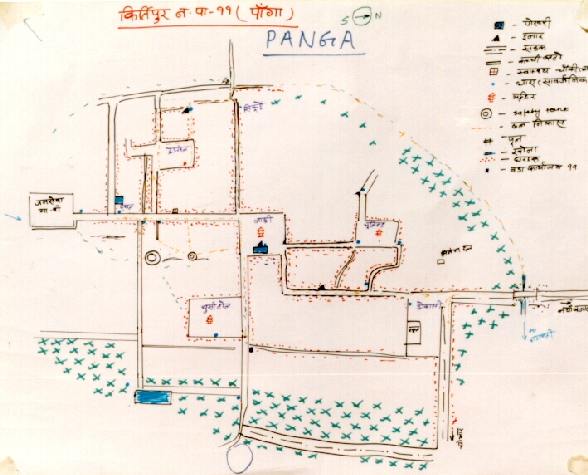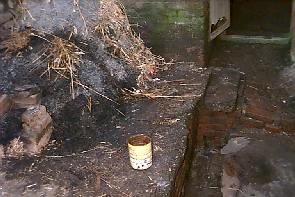

Short description of the village
A report submitted by the participants from Panga.
Panga is, or has been like Sidhipur. It has been more influenced by Kathmandu. We saw more small industry. The village also has lost much of it quality. About 950 houses, with 5500 people.
Panga occupies ward no. 9, 10, 11, and 12 of the Kirtipur Municipality. Panga's shape looks like the head of an elephant and Panga is a Newar community in the southern part of the Kathmandu Valley. 65% of the land is arable, 25% residential area and commercial area and 2% others. The length of Panga is 1500 m and breadth ranges from 300-800m. According 2048 BS census Panga has a total households of 970 and total population of 5,900. The rate of population growth is around 2%.
95% of drinking water in the community is supplied by pipes and the taps are public. 2% is supplied by wells and rest by brooks. Ponds like Dana Pukhu, Dev Pukhu and Tala Pukhu can be used for irrigation. Chikhu and Hanumanghat can be considered as rivulets. However in the absence of conservation these rivulets have been extremely polluted.
Water has been supplied in Panga by one source only which lies at Ddudhpokhari which is situated at about 1.5 km from Panga. 95% of thus supplied water in Panga has been used for domestic purposes including drinking, 20% for irrigation, 10% for cattle and cleaning and 5% for cottage industries. The wastewater from various uses have about 40% organic pollution and 30% chemical pollution. About 10% is non-biodegradable. Wastewater is disposed in rivulet through pipes. Most of the sewerage drains are closed in the residential areas. However, due to financial constraints the wastewater is disposed of untreated. Due to this the receiving streams and its surroundings have become unhealthy. The hume pipe which carries the wastewater has a diameter of 12 inch and a length of 5/600 meters and covered sewerline is about 300m and open drain is about 150m.
Of the wastewater generated, 60%,15%, and 10% is released in streams, agriculture field and ponds respectively while rest is released in open public lands. Public complaint is that unhygienic disposal of wastewater has had negative impact on air, water and indirectly on financial activities. No one is satisfied by the way the wastewater is presently disposed of and the people are eager to implement an alternative way. The commitment of the community working towards treating wastewater is appreciable. People are interested in social activities and about 75% of the people have shown interest to contribute financially also as much as they can afford. Previously when Plan International run a project of brick soling on the roads, each household contributed some money. For successful completion of small projects this community has enough technical human resource. Similarly, for sustainable management and operation various clubs, guthis etc. are active. During Devpokhari cleaning local people provided labour. Thus, till today social activities have been successfully carried out without any disturbance.
For men
90% of the people of Panga are indigenous while 10% are emigrants. There are several monuments in this community, the major ones being Bishnudevi Vajangal, Balkumari, and Bihar at Dhusi.
In this community 40% women are literate, about 65% men are educated and therefore about 50% people are educated. There are also a lot of doctors. Since the number of boarding schools has increased, about 95% of the children go to school. Most of the people of this community are farmers. About 30% are business men and service holders and 10% are unemployed.
Farmers in this community believe that untreated wastewater is harmful to crops and if it can be used for irrigation after treatment this can boost production. People are unanimous in their hope that such social problems can be solved with the help of NGOs, and INGOs. Men had contributed a lot during brick soling done in the past by the Plan International. People have no faith in Government. The projects implemented by Government is rather incomplete. For example, at Dathal a health post was constructed but is still incomplete after four years. Any work done by the Government is rather slow and social organisations do not misuse funds.
For women
Most of the women of Panga are involved in agriculture. More than 60% women do farming and household jobs. The major crops produced here are rice, wheat, mustard and beans. Food sufficient for a year is stored at home and some money earned through other works meet other expenses. This can save up to 20%.
In Panga, about 65% people have their private latrines. Those who do not have private latrines use open areas for defecation. Among those who have private latrines 55% send the wastewater in the sewer lines whereas rest of them have septic tanks. About 50% of the women are literate since women have joined adult literacy classes run for old people. So they are also aware of waterborne diseases. Since they are busy in household works they are still unaware of many things. However, they have now realised that girls should be educated also.
The source of water supply is protected and therefore waterborne disease is not that high. However, daily 15-20 people still visit the health post. The women are not satisfied with disposal of untreated wastewater and they are of the opinion that it should be treated and used for agricultural purposes. The main concern of the women is the lack of water for irrigation. They are ready to join the effort made by the community.
For old people
20% of the people in Panga are more than 50 years of age who can be categorised as elderly people. We can get information about past activities from them and also we have talked to them about present situation. The elderly people are helpful and considerate to others. They are respected in various occasions and festivals and people obey them.
Elderly people are also aware of the wastewater problem. According to them problem of wastewater was more acute 10 years ago and it has subsided at present and hope that it will minimise in the years to come. 60% of the elderly are still working. Rest can not work and advises in social activities.
People in this community suffer from diseases a few times and visit clinics for cure. In fact outbreak of communicable diseases is rare in this community.
|
|
|
Surroundings |
Activity on the street |
|
|
A dad rat on the street
|
Open defecation |

|
|
A simple toilet: use of ash to reduce odors. The ash/urine mixture was used in agriculture: a simple and effective solution!
|
An open library |
|
|